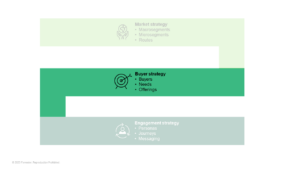[ad_1]
This is the second of a three-part series on go-to-market strategy. If you missed the key steps needed to make decisions at the first market strategy layer, you can read the blog post here.
A one-size-fits-all go-to-market strategy is nonexistent. But B2B organizations do need a methodology in place to support the creation of an audience-focused go-to-market strategy. The Forrester Go-To-Market Architecture is a comprehensive decision-making framework for evaluating different go-to-market options and choosing what is most viable for your organization. Delivering desired results requires a cascading set of decisions across three strategic layers: market, buyer, and engagement.

The buyer strategy layer guides B2B leaders on which buying departments, buying groups, and buyer personas to consider and prioritize and, once the buying audience is identified, connecting their needs to an ideal offering. This is a much different approach than organizations that tend to be product-centric and view the world from the perspective of “Who can I target for this product?” Instead, this audience-centric approach looks at the needs of a particular buying audience and intentionally aligns the best solution that will meet those needs. B2B leaders should work methodically through these steps.
Step 1: Identify The Core Buying Audience
Relying on opinion or “gut feel” about who the most important buyers are neglects the importance of buying processes and buying group dynamics. Based on the market segments being targeted, portfolio marketers must identify the key audience to prioritize. B2B purchases vary in complexity, and the roles that participants play, with the final goal of prioritizing which personas will be the primary targets for your go-to-market efforts.
Step 2: Define Primary Buyer Needs
In B2B situations, personas are influenced by the priorities, challenges, and focus of the organization that they work for. At this buyer strategy development stage, focus on defining the high-level business need or organizational need that exists. Often, these needs are reflective of an industry or company requirement to address a problem or opportunity. This step is critical, as it informs the next step of portfolio mapping.
Step 3: Map The Ideal Offering Or Solution To Buyer Needs
Portfolio mapping represents the final step in the buyer strategy layer. Once buyer personas are selected and specific buyer needs are isolated and defined, portfolio marketers work to best align which offerings within the portfolio directly meet those buyer needs. To do this work, the organization must have a documented portfolio architecture that depicts all the offerings in a portfolio (including products, services, and solutions that are available to buyers). Offerings that directly map to a buyer need represent a clear match for go-to-market execution.
When portfolio marketing leaders work alongside their sales, marketing, and product leaders to make these buyer strategy decisions, they gain alignment and clarity on which audiences and offerings will be prioritized for downstream go-to-market efforts. This ensures that revenue teams are laser-focused on building marketing and sales programs that are audience-focused and set up for success.
Forrester clients interested in learning more about the Forrester Go-To-Market Architecture can click here to access the research report. If you enjoyed this post and want to connect, you can find me on LinkedIn!
[ad_2]
Source link



